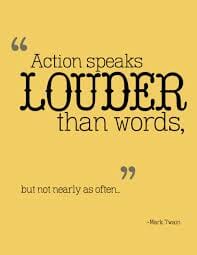Your nonprofit’s good work won’t speak for itself.
Maybe you take a quiet satisfaction in a job well done. Good for you! But if you’re the only one who knows what a great job your organization did, you’re cheating yourself.
- Who will volunteer for your organization if they don’t know what it does?
- Who will donate if they don’t know what a difference it makes?
- Who will help you change the world if they don’t know how?
- Who will speak up for you if they’ve never heard from you?
Beyond “Outreach”
Most of us know that we have to market ourselves. We just don’t like the label. “Marketing” sounds too commercial. Its cousin, “public relations,” sounds too slick. So we talk about “outreach” instead, or “visibility.”
And that’s getting in our way.
“Outreach” is just too broad. It lets us keep on thinking as if there’s some general public out there waiting to hear from us. That’s a waste of a nonprofit’s time and resources.
We need our communications to reach specific groups of people, with clearly defined messages that they want to hear. Better yet, we want those constituencies to seek us out, to be glad to hear from us, to let us know what’s on their minds, and to ask, “How can I help?”
Marketing and Public Relations for a Good Cause
Marketing and public relations don’t mean what we think they mean. I want to quote a great article by Heidi Cohen:
Marketing is everything a brand, business or organization does to sell its goods, services and values.
Public Relations…builds honest, open and transparent bridges of communication between a brand, business or organization and its constituent communities. Deborah Weinstein )
You “sell” your services to two sets of “customers”: the clients who benefit from them and the donors, funders, and volunteers who contribute to them. You “sell” them when you talk or write about them, when you answer the phone, sign your email, post to Twitter and Facebook. But you also sell them in every interaction “because if your customer service sucks, nothing else that you say matters.” (B.L. Ochman)
You build bridges and win the trust of your constituent communities “by community-building and tapping the power of positive third party, word-of-mouth, endorsement/ testimony/ tribute to create affiliation, loyalty and advocacy for your goods, services and/ or ideas,” as Deborah Weinstein says.
Ways to Do Better
You’re in the marketing and public relations business. Isn’t it worth doing them well?
Here are six ways you can improve your nonprofit’s marketing and PR.
- It’s Not About You. Get to know and love your audience and give them what they need.
- Have a Strategy. Understand what you hope each audience will give you in return and how you will move them toward doing so.
- Everybody In. Market to yourselves first. Make sure staff, Board, and volunteers get it about your organization and represent it well.
- Change the Way People Behave. Social marketing works better than a new program sometimes.
- Attract (instead of reaching out). Content marketing builds your reputation and makes people come to you.
- Take Care of Your Friends. Build loyalty among your donors, volunteers, and supporters.


